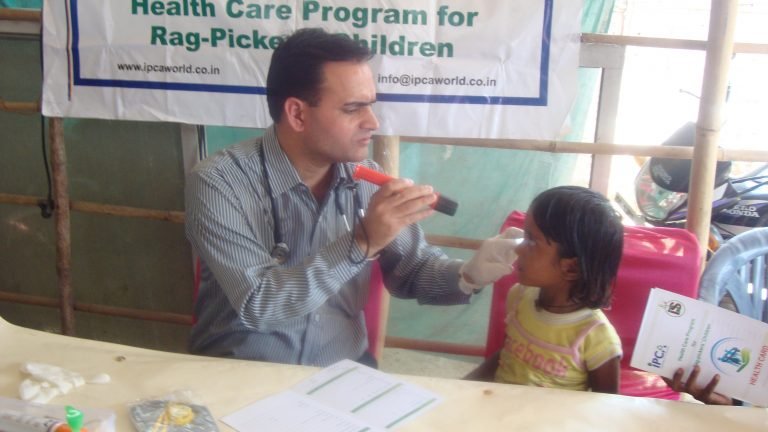IDS has received an end-of-year report from the Indian Pollution Control Association (IPCA) about the 2016 achievements of its health care and primary education programs for rag picker children. The education centers have been in operation since 2013 in Delhi NCR, and the health care program began in late 2015. Both are supported by funding from India Development Service.
Health Care
The goals of the health care program are:
 The motivation behind IPCA’s primary education program was to “break the cycle” and give the children of rag pickers a chance at an occupation other than rag picking.
To achieve this goal, the primary education centers strive to educate the children through fun learning activities (such as museum visits and holiday celebrations), grooming them for spots in the regular government education network. The program nurtures the children’s creativity by involving them in such activities as drawing, dancing, singing, and writing poetry. It encourages behavioral change while teaching concepts of good nutrition, health, and hygiene through demonstrations of hand washing and dental care.
The motivation behind IPCA’s primary education program was to “break the cycle” and give the children of rag pickers a chance at an occupation other than rag picking.
To achieve this goal, the primary education centers strive to educate the children through fun learning activities (such as museum visits and holiday celebrations), grooming them for spots in the regular government education network. The program nurtures the children’s creativity by involving them in such activities as drawing, dancing, singing, and writing poetry. It encourages behavioral change while teaching concepts of good nutrition, health, and hygiene through demonstrations of hand washing and dental care.
 The five centers currently have an enrollment of 147 students—about 60% are girls. During 2016, 30 students (about half of them girls) gained admission to government schools. Most of these students came from the Indirapuram and Barola centers.
The teachers undergo continuous training and mentoring, and special teaching aids and training materials—such as counting strings, fractions sets, number concept dominoes—have been developed. All teaching/learning activities take place in a child-friendly atmosphere, ensuring that students enjoy coming to school and are motivated to attend regularly.
The five centers currently have an enrollment of 147 students—about 60% are girls. During 2016, 30 students (about half of them girls) gained admission to government schools. Most of these students came from the Indirapuram and Barola centers.
The teachers undergo continuous training and mentoring, and special teaching aids and training materials—such as counting strings, fractions sets, number concept dominoes—have been developed. All teaching/learning activities take place in a child-friendly atmosphere, ensuring that students enjoy coming to school and are motivated to attend regularly.

- to identify malnutrition in children
- to reduce malnutrition (giving special attention to underweight children)
- to facilitate medical services
- to improve children’s physical health by means of individual examinations
 The motivation behind IPCA’s primary education program was to “break the cycle” and give the children of rag pickers a chance at an occupation other than rag picking.
To achieve this goal, the primary education centers strive to educate the children through fun learning activities (such as museum visits and holiday celebrations), grooming them for spots in the regular government education network. The program nurtures the children’s creativity by involving them in such activities as drawing, dancing, singing, and writing poetry. It encourages behavioral change while teaching concepts of good nutrition, health, and hygiene through demonstrations of hand washing and dental care.
The motivation behind IPCA’s primary education program was to “break the cycle” and give the children of rag pickers a chance at an occupation other than rag picking.
To achieve this goal, the primary education centers strive to educate the children through fun learning activities (such as museum visits and holiday celebrations), grooming them for spots in the regular government education network. The program nurtures the children’s creativity by involving them in such activities as drawing, dancing, singing, and writing poetry. It encourages behavioral change while teaching concepts of good nutrition, health, and hygiene through demonstrations of hand washing and dental care.
 The five centers currently have an enrollment of 147 students—about 60% are girls. During 2016, 30 students (about half of them girls) gained admission to government schools. Most of these students came from the Indirapuram and Barola centers.
The teachers undergo continuous training and mentoring, and special teaching aids and training materials—such as counting strings, fractions sets, number concept dominoes—have been developed. All teaching/learning activities take place in a child-friendly atmosphere, ensuring that students enjoy coming to school and are motivated to attend regularly.
The five centers currently have an enrollment of 147 students—about 60% are girls. During 2016, 30 students (about half of them girls) gained admission to government schools. Most of these students came from the Indirapuram and Barola centers.
The teachers undergo continuous training and mentoring, and special teaching aids and training materials—such as counting strings, fractions sets, number concept dominoes—have been developed. All teaching/learning activities take place in a child-friendly atmosphere, ensuring that students enjoy coming to school and are motivated to attend regularly.




